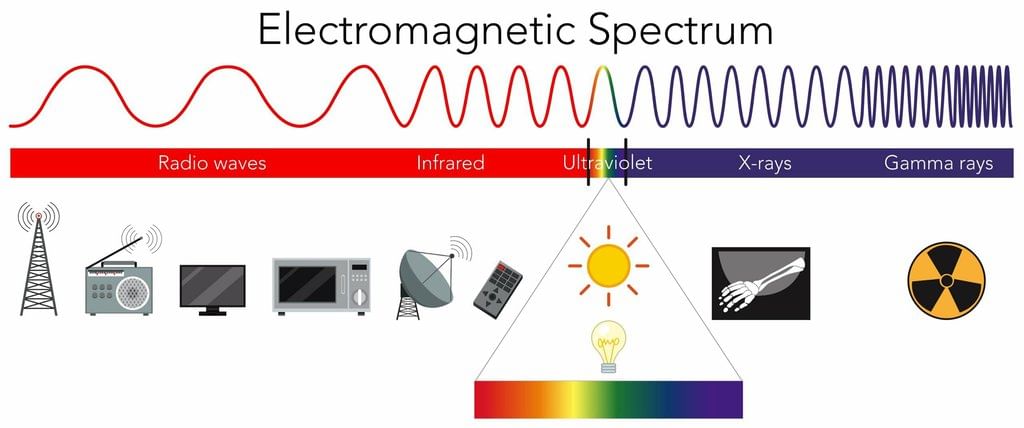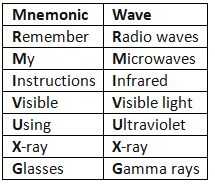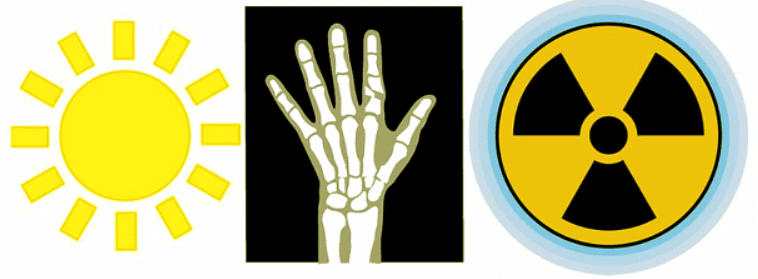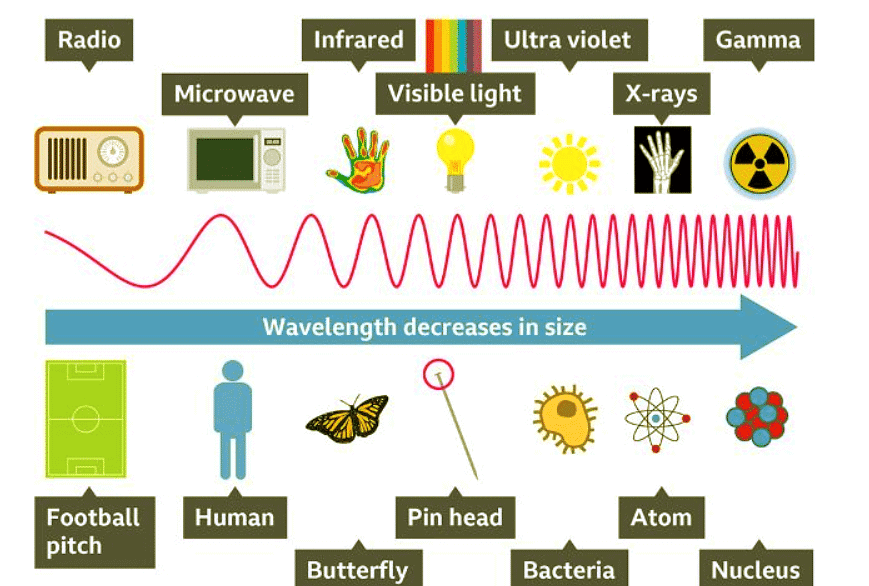The Electromagnetic Spectrum - Year 7 PDF Download
Introduction
- There are seven types of electromagnetic (EM) waves, which collectively form the electromagnetic spectrum.
- Electromagnetic waves are transverse in nature and travel at the speed of light.
- Different types of electromagnetic waves serve distinct purposes and pose varying levels of risk.
Electromagnetic (EM) waves
- Electromagnetic waves are abundant in our surroundings, comprising transverse waves that propagate at the speed of light. Examples include radio waves, microwaves, and visible light. These waves emanate from oscillating electric and magnetic fields, characterized by transverse motion where particles oscillate perpendicular to the wave's direction.
- Traveling at an astonishing pace—equivalent to the speed of light in a vacuum, roughly 300,000,000 meters per second—electromagnetic waves showcase remarkable swiftness. To illustrate, light can circumnavigate the Earth 7.5 times within a mere second.
The speed of light
- Definition: The speed of light refers to the speed at which light waves propagate through different mediums, most commonly through a vacuum.
- Explanation: In the absence of any medium, such as a solid, liquid, or gas, light travels at a constant speed of approximately 299,792 kilometers per second.
- Significance: Understanding the speed of light is crucial in various scientific disciplines, including physics and astronomy, as it serves as a fundamental constant in the universe.
The electromagnetic spectrum

The electromagnetic spectrum consists of seven distinct groups of electromagnetic waves, each with varying properties and applications. These waves are:
- Radio waves: Longest waves in the spectrum, commonly used in communication systems such as radios and televisions.
- Microwaves: Slightly shorter wavelengths than radio waves, utilized in microwave ovens and certain types of communication technology.
- Infrared: Wavelengths longer than visible light, often associated with heat radiation and infrared imaging.
- Visible light: The portion of the spectrum that is visible to the human eye, comprising different colors that can be observed in a rainbow.
- Ultraviolet: Shorter wavelengths than visible light, with applications in medicine and sterilization processes.
- X-rays: Highly energetic waves used in medical imaging to visualize internal structures of the body.
- Gamma rays: The shortest and most energetic waves in the spectrum, commonly associated with nuclear processes and astronomical observations.
Mnemonic for remembering the electromagnetic waves
- A mnemonic is a helpful tool for recalling the order of electromagnetic waves. For instance, a common mnemonic is using the phrase "Really Men Inhale Very Unusually Xylophones Generally" to remember the sequence of waves.
- Each word in the mnemonic corresponds to the first letter of each type of wave, in order of increasing frequency.

Uses of electromagnetic waves
Radio waves
Radio waves serve various purposes:
- Transmission of radio and television signals.
- Control of radio-controlled toys like cars, boats, and airplanes.
- Utilized in astronomy to study distant stars and galaxies through the radio waves they emit.
Microwaves
Microwaves have diverse applications:
- Heating food in microwave ovens.
- Communication methods such as mobile phones, Wi-Fi devices in laptops, and satellite signals.
- Usage in GPS (Global Positioning System) for satellite navigation systems.
Infrared waves
Infrared waves are employed for various functions:
- Heating and cooking food in ovens, grills, and toasters.
- Communication purposes like remote controls, internet, and telephone signals through optical fibers.
- Detection by infrared cameras for night vision and thermal imaging, used in police helicopters for surveillance.
Visible Light
- Visible light is the only form of electromagnetic radiation that is visible to the human eye.
- Besides enabling sight, visible light serves various purposes such as capturing images in cameras and forming videos.
- Laser, an acronym for Light Amplification by Stimulated Emission of Radiation, is a device that emits a concentrated beam of visible light.
- Laser beams can transmit internet and telephone signals through optical fibers.
- They find applications in surgeries and cutting materials like wood and metals using laser cutters.
Ultraviolet
- Definition: Ultraviolet (UV) waves find application in forensic science to aid in the detection of forged documents such as fake banknotes, passports, or driving licenses.
- Examples: UV waves can cause fluorescent inks in highlighters to glow brightly due to their absorption by certain materials. They are also utilized for water disinfection by eliminating bacteria.
X-rays
- Definition: X-rays are commonly utilized for producing medical images of broken bones as they can penetrate body tissues but get absorbed by bones.
- Examples: They are employed for sterilizing medical equipment, detecting broken pipes underground, and in airport security scanners.
Gamma rays
- Gamma rays, similar to X-rays, possess the capability to harm DNA within our body cells, potentially leading to the development of cancerous conditions. Individuals who are in contact with radioactive substances, such as uranium or plutonium, which emit perilous nuclear radiation, should control their exposure to gamma radiation. This is typically achieved by utilizing protective attire and limiting the duration of proximity to these materials.
- Radioactive substances like uranium or plutonium emit hazardous nuclear radiation.
- Radiation, a phenomenon akin to the spread of sound, light, or other electromagnetic waves, can be likened to waves in certain contexts, for instance, light radiation or infrared radiation.
Dangers of electromagnetic waves

- Microwaves: Due to their heating effect, powerful microwaves can be dangerous by potentially causing harm to body cells. Microwave ovens are designed not to operate with open doors to prevent this.
- Infrared: Infrared waves, through their heating effect, can cause skin burns.
- Visible light: Intense visible light, such as from lasers or the Sun, can lead to eye damage or blindness.
- Ultraviolet (UV): UV radiation can harm the eyes and skin, causing sunburn or potentially damaging DNA in cells, which may increase the risk of skin cancer. Sunglasses often block UV to protect the eyes.
- X-rays: X-rays have the potential to damage DNA, leading to internal cancers. Although low exposure levels (like a few medical x-rays annually) are generally safe, precautions are essential for those regularly working with X-rays.
- Gamma rays: Similar to X-rays, gamma rays can damage DNA and increase the risk of developing internal cancers. Those working with radioactive materials emitting gamma rays must limit exposure, wearing protective gear and minimizing time spent near these substances.
Wavelengths of electromagnetic waves
Different parts of the electromagnetic spectrum are characterized by varying ranges of wavelengths. These wavelength ranges influence how each type of electromagnetic wave behaves and how it interacts with different materials. Each region of the electromagnetic (EM) spectrum has a range of wavelengths associated with it. Radio waves have the longest wavelengths and gamma rays have the shortest wavelengths.
Each region of the electromagnetic (EM) spectrum has a range of wavelengths associated with it. Radio waves have the longest wavelengths and gamma rays have the shortest wavelengths.
Radio Waves
- Radio waves possess the longest wavelengths among all electromagnetic waves, ranging from thousands of meters down to approximately 30 cm.
- This extensive wavelength range enables them to navigate easily around obstacles such as hills, mountains, and buildings. For instance, radio signals can bend over mountains to reach receivers located behind them.
Microwaves
- Microwaves exhibit wavelengths ranging from around 30 cm to 1 mm. Due to this characteristic, microwaves are readily absorbed by molecules of fat and water, leading to their heating effect.
- An everyday example is a microwave oven, which uses microwaves to heat food efficiently.
Infrared Waves
- Infrared waves possess wavelengths that are approximately 1 millimeter or even smaller. They are easily absorbed by dark, matte objects and are known for their heating properties.
- For instance, infrared radiation is utilized in thermal imaging cameras to detect temperature differences in various objects.
Visible Light
- Visible light has wavelengths slightly less than one-thousandth of a millimeter.
Ultraviolet Waves
- Ultraviolet waves have wavelengths slightly shorter than visible light waves. They are small enough to damage DNA in skin cells, potentially leading to skin cancer.
X-rays
- X-rays have wavelengths around one millionth of a millimeter. They can easily pass through soft tissues but are absorbed by bone. These waves are tiny enough to enter cells and can harm DNA, potentially causing cancer.
Gamma Rays
- Gamma rays are extremely small electromagnetic waves that can penetrate cells and harm DNA, potentially leading to the development of cancers.
- To fill a one millimeter gap, approximately 10 million gamma waves are required.
FAQs on The Electromagnetic Spectrum - Year 7
| 1. What are electromagnetic waves? |  |
| 2. What is the speed of light in a vacuum? |  |
| 3. What are some common uses of electromagnetic waves? |  |
| 4. What are the dangers associated with electromagnetic waves? |  |
| 5. What are the different wavelengths of electromagnetic waves in the electromagnetic spectrum? |  |



















